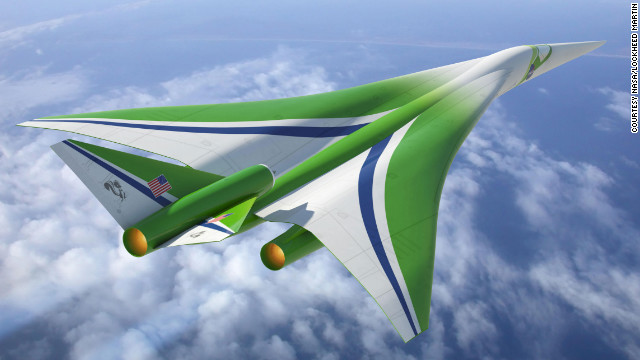
For more than three decades, Concorde represented the pinnacle of business travel -- the ultimate status symbol for the jetset executive.
Considered a marvel of
aviation technology, the distinctive droop-nosed aircraft traveled at
twice the speed of sound, flying from London to New York in about three
and a half hours -- half the time of commercial airliners.
But even before an Air
France Concorde crashed in 2000, killing all 100 passengers and nine
crew members on board, the luster was beginning to wane.
Battling high operating
costs and low passenger numbers, Air France and British Airways grounded
their small, aging fleet a mere three years later.
But the dream of supersonic flight
has not disappeared. Aviation manufacturers such as Boeing, Lockheed
Martin and Aerion are working on supersonic technology -- with the
latter predicting it could have a supersonic business jet in service as
early as 2020.
Industry expert Joe Lissenden, the director of aerospace and defense consulting in the Americas for IHS Jane's, says it's likely that a next-generation supersonic commercial aircraft will emerge.
High demand from
passengers, historic profitability on the routes and significant
technological improvements have combined to make supersonic flight all
the more viable, he said.
For Lissenden, the one
challenge that remains is fuel cost. "Faster flights consume fuel faster
which makes the flight more expensive," he said. "But this is a premium
route, and premium prices will be charged."
Crucial to the efforts
to restore supersonic aircraft to the skies is the work of national
aerospace programs such as NASA and Japan's JAXA. Peter Coen is the
supersonics research project manager for NASA's fundamental aeronautics
program.
While the agency is not
working on a specific supersonic aircraft, he said, "we are working on
technologies we feel represent barriers to bringing back successful
supersonic aircraft."
Those barriers include
high atmosphere emissions, noise produced when taking off and landing,
and the sonic boom -- the sound associated with the shockwaves created
when objects travel faster than the speed of sound, which has prevented
supersonic aircraft from flying overland routes.
Coen said his division
was concentrated on addressing the sonic boom issue first, because "if
you don't have overland supersonic flight, there's never going to be a
market for the supersonic aircraft."
NASA has been
collaborating with Boeing and Lockheed Martin on systems-level design
studies, with each manufacturer producing models that have been
subjected to wind tunnel testing to gauge their effectiveness.
Coen said phase one
testing had successfully validated the basic design techniques.
Reshaping the aircraft, the designs -- Boeing's two-jet configuration
with engines mounted above the wing, and Lockheed Martin's tri-jet
configuration, with two engines below the wing and a third mounted in
the tail -- had been proven to significantly reduce the sonic boom to a
"thump," dropping the noise from Concorde levels to close to what is
considered the level of acceptability.
Coen said he expected to
see a next-generation "son of Concorde" in the marketplace by around
2030, while a supersonic business jet "could happen sooner."
"The boom is the barrier
and if we can get past that, I think we'll see people giving supersonic
flight a lot more serious consideration," he said.
The Japan Aerospace
Exploration Agency (JAXA) also hopes to develop a supersonic passenger
aircraft that is quiet, economical and environmentally friendly, and
expects to achieved it some time this century.
Spokesman Masahisa Honda
said that while the agency currently had no aircraft in specific
development, along current projections it predicted a supersonic
business jet to enter the market some time after 2015.
One of the frontrunners
to do so is the Aerion SBJ, an 8-12 passenger business jet. "It will
herald a return to supersonic civil flight without Concorde's
environmental and economic drawbacks," said Aerion spokesman Adam
Konowe.
He said development of a
joint venture with aircraft manufacturers to produce the SBJ had been
slowed by the recession, but once a deal was struck he anticipated a
six-year development program to bring the aircraft to market. "We
believe the SBJ will be certified, and enter service around the end of
the decade -- 2020," he said.
But not everyone is
convinced that a return to supersonic passenger flight is just around
the corner. Chris Seymour, head of market analysis with aviation experts
Ascend, was skeptical that there would be much progress before at least 2030.
"I think there's so many issues to be considered that I certainly can't see it happening in the next 20 years," he said.
Seymour believes that
although technological barriers will likely be overcome, the key factor
in whether it will become a reality is whether a market exists that is
prepared to pay a premium for the ultimate status symbol in business
travel -- particularly in an air-travel market that is focused on low
prices.
"Will you have enough
passengers willing to pay higher fares to fly more quickly?" He said.
"If you look at Concorde, that wasn't the case. It came along at a time
when the 747 also came in, which carried more people for lower fares.
That's where the market was."
Peter Warth, director of Complete Aviation Solutions, also believes that a return to supersonic flight is further off than some are making out.
"There seems to be multiple technological and commercial obstacles that will need to be cleared," he said.
But he conceded: "I'm
sure that when the original plans for Concorde, the A380 and the 787
Dreamliner were announced, the same questions about whether it could be
achieved were asked. But they eventually delivered. I think time will
tell."
Retweet this story
No comments:
Post a Comment